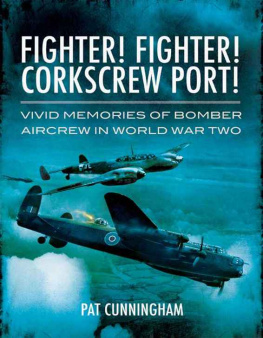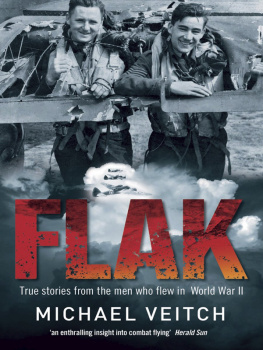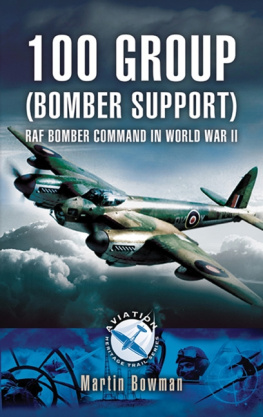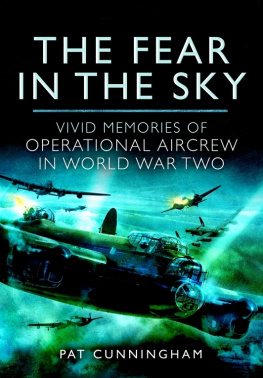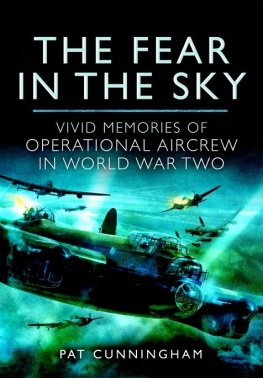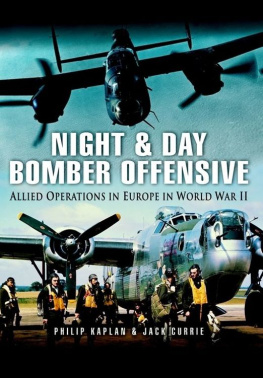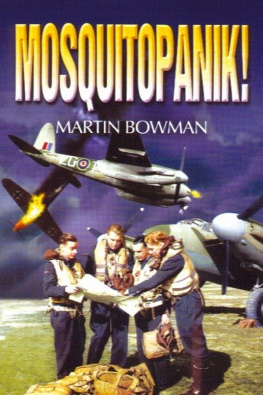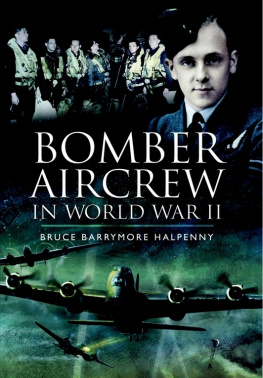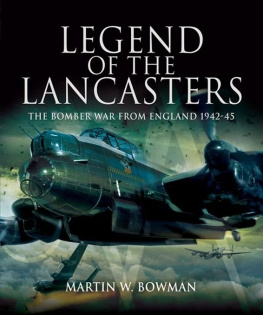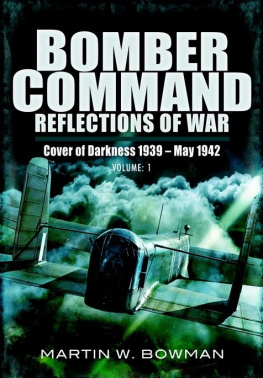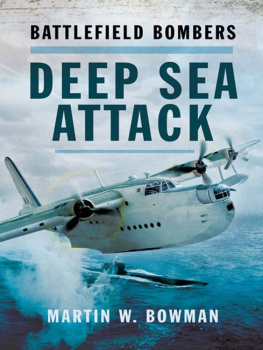
Other Books by the Author
Non-fiction
Peakland Aircrashes Series:
The South (2005)
The Central Area (2006)
The North (2006)
High Peak Air Crash Sites, Central Region
White Peak Air Crash Sites
Bomb on the Red Markers
Faction
A Magnificent Diversion Series (Acclaimed by the First World War Aviation Historical Society)
The Infinite Reaches 191516
Contact Patrol 1916
Sold A Pup 1917
The Great Disservice 1918
Blind Faith: Joan Waste, Derbys Martyr
Joyce Lewis of Mancetter, Lichfields feisty Martyr
Fiction
In Kinders Mists (a Kinderscout ghost story),
Though the Treason Pleases (Irish Troubles),

First published in Great Britain in 2012 by
PEN & SWORD AVIATION
An imprint of
Pen & Sword Books Ltd
47 Church Street
Barnsley
South Yorkshire
S70 2AS
Copyright Pat Cunningham 2012
ISBN 978 1 84884 655 5
Digital Edition ISBN: 978 1 78340 783 5
The right of Pat Cunningham to be identified as Author of this work has been
asserted by him in accordance with the Copyright, Designs and Patents Act 1988.
A CIP catalogue record for this book is available from the British Library
All rights reserved. No part of this book may bereproduced or transmitted
in any form or by any means, electronic or mechanical including photocopying,
recording or by any information storage and retrieval system,
without permission from the Publisher in writing.
Pen & Sword Books Ltd incorporates the Imprints of Pen & Sword Aviation,
Pen & Sword Family History, Pen & Sword Maritime, Pen & Sword Military,
Pen & Sword Discovery, Wharncliffe Local History, Wharncliffe True Crime,
Wharncliffe Transport, Pen & Sword Select, Pen & Sword Military Classics,
Leo Cooper, The Praetorian Press, Remember When, Seaforth Publishing
and Frontline Publishing
Printing in England by Anthony Rowe UK.
For a complete list of Pen & Sword titles please contact
PEN & SWORD BOOKS LIMITED
47 Church Street, Barnsley, South Yorkshire, S70 2AS,England
E-mail:
Website: www.pen-and-sword.co.uk.
Contents
Who, Sir, was Glenn Miller?
Pilot Officer Ron Brown, flight engineer
My Three Wars
Warrant Officer Andrzej Wesolowski (Russel), KM [Krzy Walecznych: Cross of Valour], Polish Air Force under British Command, wireless operator/air gunner
Malicious Cookies and merciful manna
Squadron Leader Bill Hancock, BSc, navigator
In the swim
Flight Sergeant Norman Shepherd, BEM, flight engineer
Jeez, theyre shooting at us!
Flight Lieutenant Oliver Gomersall, navigator ...
I gained six brothers
Warrant Officer Ted Peck, flight engineer ...
I want to kill the bastards, not photograph them
Squadron Leader Ian Linney, OBE, DL, pilot
The bridge without a name
Flight Sergeant Thomas Cotter, air gunner
Someone something kept an eye on me
Flight Sergeant Peter McGrath, wireless operator/air gunner
I hope something exciting happens tonight
Warrant Officer Robert (Bob) Willis Petty, DFC, pilot
Acknowledgments
To the traced copyright holders for authorizing the use of their photographs: Richard Haigh, manager, intellectual properties, Rolls-Royce; Nicola Hunt, intellectual property rights copyright unit, MOD; archives staff, Imperial War Museum; Judy Nokes, licensing adviser, HMSO (Crown Copyright/MOD); archives staff, Royal Air Force Museum.
Craving the indulgence of those for whom all contact attempts have failed.
To Julian Temple and John Lattimore, of Brooklands Museum for their Wellington expertise.
To Clive Teale, aviator and grammarian, for technical advice. Similarly to Ken Johnson and Ken Clare for down-to-earth criticism.
To the photographic staff at ASDA, Spondon, who, if irreverent, gave unstinting assistance; similarly, to the staff at the co-located McDonalds, for sustenance.
To the Chief Executive of Derwent Living, winter 2010 - 2011 (the coldest in 100 years): for no central heating, and memorable proofreading of four books in fingerless gloves.
Despite such inestimable assistance, any errors remaining, and all opinions expressed, are my own.
Pat Cunningham, DFM
Introduction
This book is a tribute to the Second World War aircrews of the Royal Air Force who, for much of that conflict, were Britains only direct means of striking back at the enemy. And yet until a short time before the outbreak of war the RAFs concept of aircrew was hazy to say the least, indeed, the term itself did not gain currency until 1939. Fortunately, in 1934 perceptive elements in the government authorized a massive expansion of the RAF. However, as an unlooked-for outcome this also showed up serious shortcomings.
Paramount among these was the lack of a cohesive policy for the crewing of aircraft, and particularly of the heavy bombers which, even then, were long past the drawing-board stage. Essentially, the system regarded only pilots as full-time fliers. The others, observers and air gunners, were invariably found among volunteer tradesmen whose technical qualifications were rather wastefully misemployed when they were called from the workshops to fly.
There was also the woeful state of navigation, illustrated by the fact that in a two-year period 478 RAF bombers made forced-landings because their pilots had lost their way. And that was over Britain, when venturing aloft at night, over a fully-lit land!
Steps taken to rectify matters included sending all observers on ten-week navigation courses. Even so, just two months before the outbreak of war the Commander in Chief of Bomber Command, Air Chief Marshal Ludlow-Hewitt, was obliged to report to the Air Council that his command was incapable of operating in anything but fair weather.
In the interim air gunners and observers had been established as full-time fliers and, nominally, at least, made sergeants, although this would take time to implement. Even so, the gunners were expected to double as wireless operators, and the observers as bomb aimers. Clearly, to fully crew the anticipated heavy bombers would be an enormous undertaking calling for the economic husbanding of resources.
The requirements decided upon for these yet-to-be-found fliers were not particularly flattering. The medically suitable aspirant volunteer, while not exceptional, was to be more than keen to learn. A mechanical background would be advantageous and he should have a good general education with a fair working knowledge of maths and the application of simple formulae. It was to be left to the Initial Training Wing (ITW) to bring out the dormant spirit of aggression and to maintain personal initiative while encouraging the crew spirit.
Meanwhile, the creation of instant sergeants did not sit happily with the non-fliers in a Service where promotion had been historically slow. But the new planners were also stuck with another historical precedent, that of commissioned and non-commissioned fliers that had been foisted upon the Service since the earliest days. In 1914 Trenchard the revered Father of the RAF had seen no need to commission pilots, reasoning that they commanded nobody and that the trained military observer they carried would regulate the sortie. The Royal Naval Air Service, however, offered commissions to its pilots, so that, suddenly facing a dearth of recruits, the Royal Flying Corps had to follow suit.

